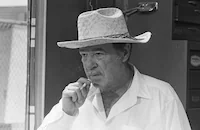Yellowstone Kelly

Brief Synopsis
Cast & Crew
Gordon Douglas
Clint Walker
Edward Byrnes
John Russell
Ray Danton
Claude Akins
Film Details
Technical Specs

Synopsis
Luther "Yellowstone" Kelly, trapper, surveyor and Indian scout, arrives at the Yellowstone River to board a steamship bound for Fort Buford, where he plans to sell his skins. At the fort, Major Towns, the commanding officer, asks Kelly to scout the Sioux territory south of the Missouri for the Army, and Kelly reluctantly agrees, setting out with Anse Harper, a young man he met on the steamship. As they approach the Snake River, they are captured by Sayapi, a young Sioux, and brought before Gall, chief of the Seven Nations and a hater of whites. Gall reminds Kelly that seven years earlier, Kelly had saved his life after Gall was shot by soldiers and left for dead, and he now demands that Kelly do the same for a captured Arapaho, a beautiful maiden named Wahleeah. Kelly manages to remove the bullet from her spine, and Gall allows Kelly and Anse to leave, despite Sayapi's objections. Later, Wahleeah, having managed to escape from the Sioux, approaches Kelly's cabin half-dead from fever, and when Kelly warns that she will die if she is moved, Gall orders that she remain there until the winter, provoking a jealous outburst by Sayapi. When she revives, Wahleeah asks Kelly to take her to her own people, but he refuses, unwilling to let anything interfere with his trapping. Aware that soldiers are about to cross the river, Kelly warns Major Towns that a thousand Sioux are on the other side, but Towns, eager to punish the Sioux for the massacre at Little Bighorn, orders his soldiers to drive them back to the Dakota Territory. While, Kelly is with the soldiers, Anse decides to take Wahleeah back to her people, but in a violent confrontation, Sayapi and his men stop them, and Kelly returns to find his house aflame and Anse dying. An anguished Kelly tracks Sayapi to a cave and kills him, then rescues Wahleeah and tells her he will now return her to her tribe. When Kelly learns that Major Downs died in an attack by the Sioux, and the surviving soldiers are surrounded, he goes unarmed to meet Gall, who offers Kelly his freedom in exchange for Wahleeah, but insists that the soldiers must die. Kelly refuses, and Gall orders the Sioux to attack. When Kelly asks Gall how many more must die, proclaiming that the land no longer smiles on the Sioux people, Gall leaves in frustration. Sometime later, Kelly and Wahleeah ride mules to the river, where he signals a steamship to stop for them.

Director

Gordon Douglas
Cast

Clint Walker

Edward Byrnes
John Russell

Ray Danton

Claude Akins
Rhodes Reason

Andra Martin
Gary Vinson

Warren Oates
Harry Shannon
Buff Brady
Nesdon Booth
Chief Yowlachie
Vince St. Cyr
Clyde Howdy
Foster Hood
Crew
Harold Barker
Gordon Bau
Marjorie Best
Bill Cline
Stanley Fleischer
Carl Guthrie
Bill Hawkes
Howard Hohler
Howard Jackson
Vic Johnson
Burt Kennedy
Roy Kennedy
Bill Kissel
Ed Luckey
Larry Meek
M. A. Merrick
William Wallace
Levi Williams
William Ziegler

Videos
Movie Clip


Film Details
Technical Specs

Articles
Yellowstone Kelly
By Frank Miller

Yellowstone Kelly
Quotes
The Major is in a hurry to get buried on a Montana mountain.- Sergeant
Yeah, he said he was gonna cross the Yellowstone and jump the Sioux.- Yellowstone Kelly
Will he try a fool thing like that?- Anse Harper
If he does, the ground is going to be full of soldiers.- Yellowstone Kelly
Trivia
Notes
Although an August 1957 Hollywood Reporter news item reported that Jules Schermer would produce the film, his contribution has not been confirmed. According to the pressbook for the film, scenes were shot in Arizona in and around Flagstaff, the San Francisco Peaks area and Sedona, where the battle at the end was filmed. The pressbook states that 114 Navajo Indians portrayed Sioux warriors. The film featured stars from three Warner Bros.-produced ABC-TV series: Clint Walker of Cheyenne; Edward Byrnes, who played "Kookie" on 77 Sunset Strip; and John Russell of Lawman. Reviewers noted that this film would test whether stars of television would attract viewers to movie theaters.
Variety commented, "Box office response to this picture will provide more data on the question of whether stars developed in teleseries can draw paying customers on the strength of their names rather than tv characters they portray. It's a good bet that they will, especially in this combination." Motion Picture Daily predicted that the stars' "names May well bring out to theaters that part of the so-called 'lost' audience which has been lost because of TV westerns and action dramas." Variety praised the film's "craftsmanship in every department" which, it suggested, "displayed the three tv heroes in a production framework not approachable in telefilming." Los Angeles Mirror-News called the film "a throwback to those Technicolored cavalry versus Indian days before the movie western went somberly psychological, tense and black-and-white."
Luther "Yellowstone" Kelly (1849-1928) was a real historical figure who became a well-known trapper and Indian scout in Wyoming. Another film featuring Kelly is the 1956 United Artists picture Gun Brothers.

Miscellaneous Notes
Released in United States 1959
Released in United States 1959













